Automation Composition Management: Architecture and Design
To get a feature, service, or capability working in modern networks is not straightforward. It is not as simple as deploying a microservice or running a workflow. Our features, services, and capabilities are now typically delivered using loose compositions of microservices, rules, algorithms, configurations, and workflows. Of course, we use workflows and deploy microservices, but how do we keep track of what workflow activated which service or what microservice instance enables a given capability. We must be able to deploy, keep track of, amend, and remove the compositions that combine to give us our features, services and capabilities, that is we must manage those compositions.
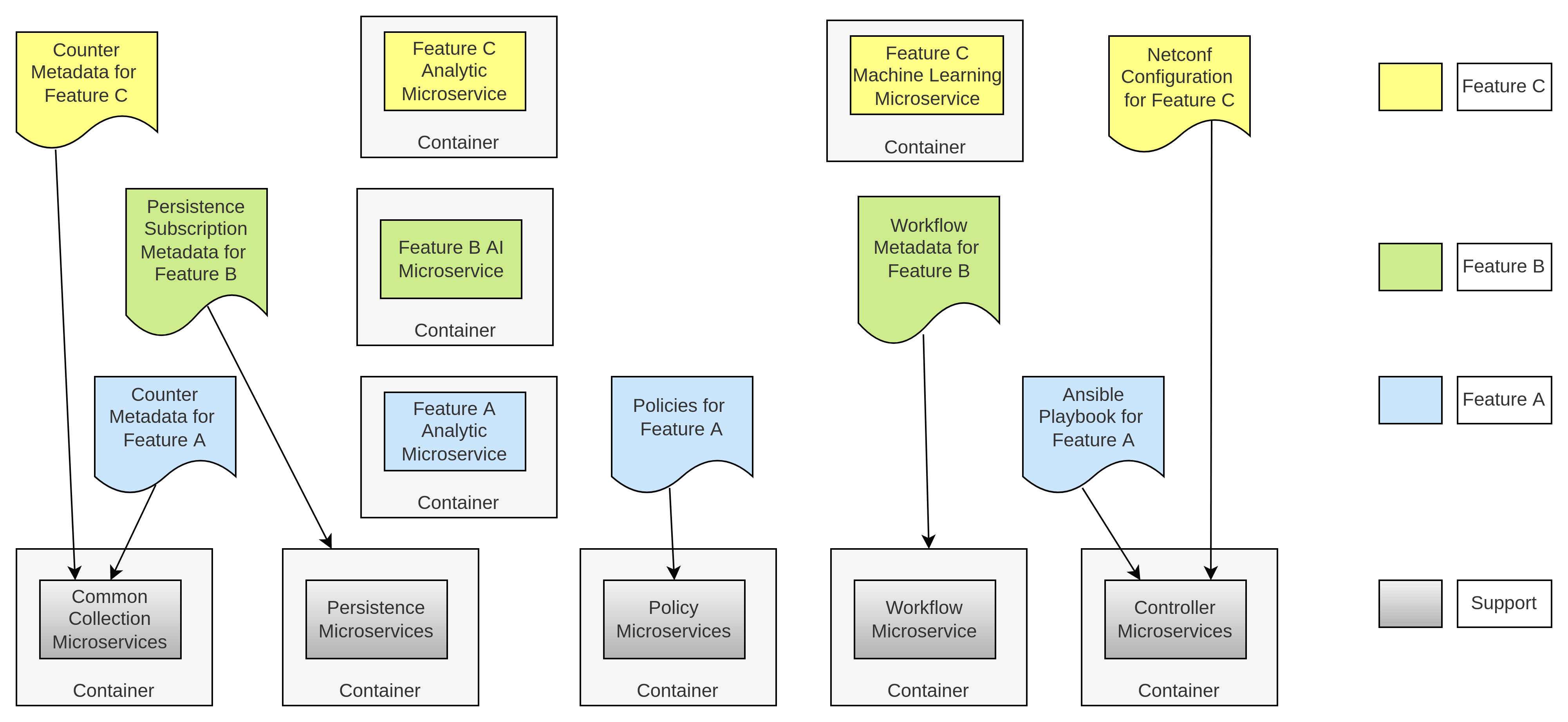
Consider Features A, B and C in the diagram above.
Feature A is realised as an Analytic Microservice, but it also requires counters to be configured in a collection service to enable its input stream of data. It also requires two policies to be present, and its result requires an Ansible playbook to be present.
Feature B is realised as an AI microservice, which is triggered by a set of triggers that are configured in the persistence service. The AI algorithm in Feature B triggers a workflow in the workflow service
Feature C is realised as two microservices, an analytic microservice and a Machine Learning microservice. The feature also requires that certain counters are collected and certain Netconf configurations are enabled.
All three features are realised as Automation Compositions, as shown in the diagram below.
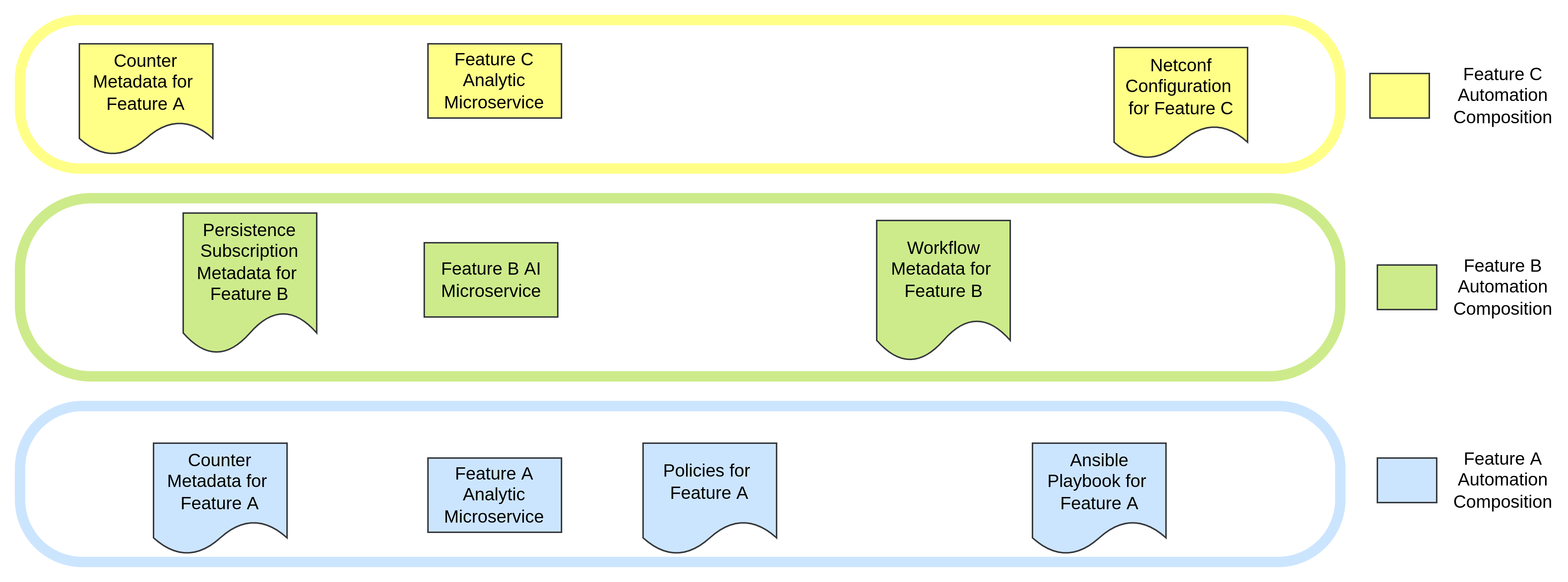
The ability to deploy features in a scalable, flexible and loosely coupled microservice architecture is of course a major step forward from layered architectures of the past. However, managing at “Feature” level in such architectures does present challenges. For example, to manage the three running instances of Features A to C above, 9 separate elements must be kept track of. There is nothing in the deployed system to sat what element is related to what other element, and what element are working together to realise a feature.
Automation Composition Management (ACM) is a framework that supports Life Cycle Management of Automation Compositions. It supports deployment, monitoring, update and removal of Automation Compositions en-bloc, allowing users to manage their features, services, and capabilities as single logical units.
1 Introduction
The idea of using automation compositions to automatically (or autonomously) perform network management
has been the subject of much research in the Network Management research community, see
this paper for some background. However, it is only with
the advent of ONAP that we have a platform that supports automation compositions for network management.
Before ONAP, Automation Compositions have been implemented by hard-coding components together and hard
coding logic into components. ONAP has taken a step forward towards automatic implementation
of Automation Compositions by allowing parameterization of Automation Compositions that work on the premise that
the Automation Compositions use a set of analytic, policy, and control components connected together in
set ways.
The goal of the work is to extend and enhance the current ONAP Automation Composition support to provide a complete open-source framework for Automation Compositions. This will enhance the current support to provide TOSCA based Automation Composition definition and development, commissioning and run-time management. The participants that comprise a Automation Composition and the metadata needed to link the participants together to create a Automation Composition are specified in a standardized way using the OASIS TOSCA modelling language. The TOSCA description is then used to commission, instantiate, and manage the Automation Compositions in the run time system.
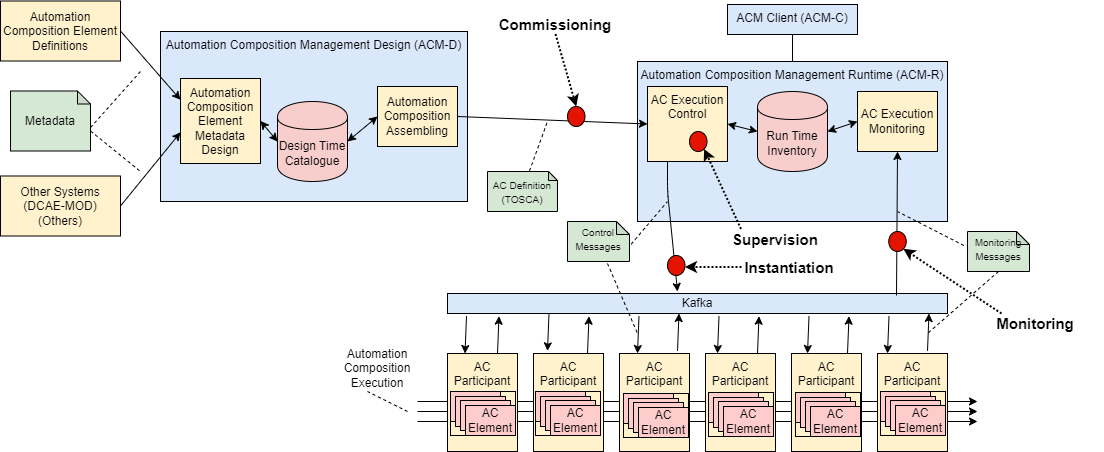
2 Terminology
This section describes the terminology used in the system.
2.1 Automation Composition Terminology
Automation Composition Type: A definition of a Automation Composition in the TOSCA language. This definition describes a certain type of a automation composition. The life cycle of instances of a Automation Composition Type are managed by ACM.
Automation Composition Instance: An instance of a Automation Composition Type. The life cycle of a Automation Composition Instance is managed by ACM. An Automation Composition Instance is a set of executing elements on which Life Cycle Management (LCM) is executed collectively. For example, a set of microservices may be spawned and executed together to deliver a service. This collection of services is a automation composition.
Automation Composition Element Type: A definition of a Automation Composition Element in the TOSCA language. This definition describes a certain type of Automation Composition Element for a automation composition in a Automation Composition Type.
Automation Composition Element Instance: A single entity executing on a participant, with its Life Cycle being managed as part of the overall automation composition. For example, a single microservice that is executing as one microservice in a service.
Automation Composition Runtime: The ACM Runtime server that holds Automation Composition Type definitions and manages the life cycle of Automation Composition Instances and their Automation Composition Elements in cooperation with participants.
2.2 Participant Terminology
Participant Type: Definition of a type of system or framework that can take part in control loops and a definition of the capabilities of that participant type. A participant advertises its type to the CLAMP Automation Composition Runtime.
Participant: A system or framework that takes part in automation compositions by executing Automation Composition Elements in cooperation with the Automation Composition Runtime. A participant chooses to partake in automation compositions, to manage Automation Composition Elements for ACM, and to receive, send and act on LCM messages for the ACM runtime.
2.3 Terminology for Properties
Common Properties: Properties that apply to all Automation Composition Instances of a certain Automation Composition Type and are specified when a Automation Composition Type is commissioned.
Instance Specific Properties: Properties that must be specified for each Automation Composition Instance and are specified when a Automation Composition Instance is Initialized.
2.4 Concepts and their relationships
The UML diagram below shows the concepts described in the terminology sections above and how they are interrelated.
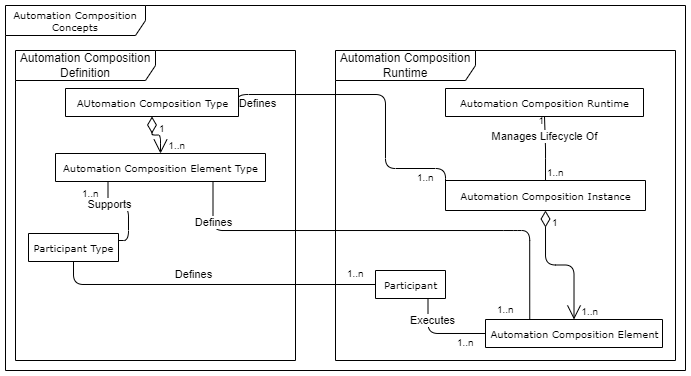
The Automation Composition Definition concepts describe the types of things that are in the system. These concepts are defined at design time and are passed to the runtime in a TOSCA document. The concepts in the Automation Composition Runtime are created by the runtime part of the system using the definitions created at design time.
3 Capabilities
We consider the capabilities of Automation Compositions at Design Time and Run Time.
At Design Time, three capabilities are supported:
Automation Composition Element Definition Specification. This capability allows users to define Automation Composition Element Types and the metadata that can be used on and configured on a Automation Composition Element Type. Users also define the Participant Type that will run the Automation Composition Element when it is taking part in in a automation composition. The post condition of an execution of this capability is that metadata for a Automation Composition Element Type is defined in the Automation Composition Design Time Catalogue.
Automation Composition Element Definition Onboarding. This capability allows external users and systems (such as SDC or DCAE-MOD) to define the metadata that can be used on and configured on a Automation Composition Element Type and to define the Participant Type that will run the Automation Composition Element when it is taking part in in a automation composition. The post condition of an execution of this capability is that metadata for a Automation Composition Element Type is defined in the Automation Composition Design Time Catalogue.
Automation Composition Type Definition. This capability allows users and other systems to create Automation Composition Type definitions by specifying a set of Automation Composition Element Definitions from those that are available in the Automation Composition Design Time Catalogue. These Automation Composition Elements will work together to form Automation Compositions. In an execution of this capability, a user specifies the metadata for the Automation Composition and specifies the set of Automation Composition Elements and their Participant Types. The user also selects the correct metadata sets for each participant in the Automation Composition Type and defines the overall Automation Composition Type metadata. The user also specifies the Common Property Types that apply to all instances of a automation composition type and the Instance Specific Property Types that apply to individual instances of a Automation Composition Type. The post condition for an execution of this capability is a Automation Composition definition in TOSCA stored in the Automation Composition Design Time Catalogue.
Note
Once a Automation Composition Definition is commissioned to the Automation Composition Runtime and has been stored in the Run Time Inventory, it cannot be further edited unless it is decommissioned.
At Run Time, the following participant related capabilities are supported:
System Pre-Configuration. This capability allows participants to register and deregister with ACM-R. Participants explicitly register with ACM-R when they start. The post condition for an execution of this capability is that a participant becomes available (registration) or is no longer available (deregistration) for participation in an Automation Composition.
At Run Time, the following Automation Composition Life Cycle management capabilities are supported:
Automation Composition Commissioning: This capability allows version controlled Automation Composition Type definitions to be taken from the Automation Composition Design Time Catalogue and be placed in the Commissioned Automation Composition Inventory. It also allows the values of Common Property Types that apply to all instances of a Automation Composition Type to be set. The post condition for an execution of this capability is that the Automation Composition Type definition is in the Commissioned Automation Composition Inventory.
Automation Composition Priming on Participants. The Priming operation sends Automation Composition Types and common property values to participants for each Automation Composition Element Type in the Automation Composition Type. The participant can then take whatever actions it need to do to support the automation composition type in question. Automation Composition Priming is triggered by user interaction with the ACM-R Rest API. The post condition for an execution of this capability is that the AC definitions are primed on all participants, that is they are prepared to run instances of their Automation Composition Element types. Automation composition definitions cannot be primed until they are commissioned.
Automation Composition Instance Life Cycle Management: This capability allows a Automation Composition Instance to have its life cycle managed.
Automation Composition Instance Creation: This capability allows an Automation Composition Instance to be created. The Automation Composition Type definition is read from the Commissioned Automation Composition Inventory and values are assigned to the Instance Specific Property Types defined for instances of the Automation Composition Type by the ACM client. An Automation Composition Instance that has been created but has not yet been deployed on participants is in deploy state UNDEPLOYED and lock state LOCKED. In this state, the Instance Specific Property Type values can be revised and updated as often as the user requires. The post condition for an execution of this capability is that the Automation Composition instance is created in the Instance Automation Composition Inventory but has not been deployed on Participants.
Automation Composition Instance Update on Participants: The AC instance property values can be updated before/after the instance deployment. Before the deployment, the new property values are only updated on the runtime database whereas the updated property values are also sent to the participants when the instance is in DEPLOYED state. The post condition for an execution of this capability is that the Automation Composition instance is updated on Participants.
Automation Composition State Change: The user can now order the participants to change the state of the Automation Composition Instance. If the Automation Composition is set to deploy state DEPLOYED and lock state UNLOCKED, each participant begins accepting and processing automation composition events and the Automation Composition Instance is set to state DEPLOYED/UNLOCKED in the Instantiated Automation Composition inventory. The post condition for an execution of this capability is that the Automation Composition instance state is changed on participants.
Automation Composition Instance Monitoring: This capability allows Automation Composition Instances to be monitored. Users can check the status of Participants, Automation Composition Instances, and Automation Composition Elements. Participants report their overall status and the status of Automation Composition Elements they are running periodically to ACM-R. ACM aggregates these status reports into an aggregated Automation Composition Instance status record, which is available for monitoring. The post condition for an execution of this capability is that Automation Composition Instances are being monitored.
Automation Composition Instance Supervision: This capability allows Automation Composition Instances to be supervised. The ACM runtime expects participants to report on Automation Composition Elements periodically. The ACM runtime checks that periodic reports are received and that each Automation Composition Element is in the state it should be in. If reports are missed or if a Automation Composition Element is in an incorrect state, remedial action is taken and notifications are issued. The post condition for an execution of this capability is that Automation Composition Instances are being supervised by the ACM runtime.
Automation Composition Instance Removal from Participants: A user can order the removal of a Automation Composition Instance from participants. The post condition for an execution of this capability is that the Automation Composition instance is removed from Participants.
Automation Composition Instance Deletion: A user can order the removal of a Automation Composition Instance from the ACM runtime and participants. Automation Composition Instances that are DEPLOYED/UNLOCKED on participants cannot be removed from the ACM runtime. Each participant begins accepting and processing automation composition events removing the Automation Composition Instance from the inventory. The post condition for an execution of this capability is that the Automation Composition instance is removed from Instance Automation Composition Inventory in ACM runtime and participants.
Automation Composition Depriming on Participants. The Depriming operation removes Automation Composition Types and common property values from participants for each Automation Composition Element Type in the Automation Composition Type. Automation Composition Depriming is triggered by user interaction with the ACM-R Rest API. The post condition for an execution of this capability is that the AC definitions are deprimed on all participants, that is they are no longer prepared to run instances of their Automation Composition Element types. Automation composition definitions cannot be deprimed on a participant until the instances for that participant are deleted.
Automation Composition Decommissioning: This capability allows version controlled Automation Composition Type definitions to be removed from the Commissioned Automation Composition Inventory. An Automation Composition Definition that has instances in the Instantiated Automation Composition Inventory or has not been deprimed on participants cannot be removed. The post condition for an execution of this capability is that the Automation Composition Type definition removed from the Commissioned Automation Composition Inventory.
Note
The system dialogues for run time capabilities are described in detail on the System Level Dialogues page.
3.1 Automation Composition Instance States
When an automation composition definition has been commissioned and primed, instances of the automation composition can be created, updated, and deleted. The system manages the lifecycle of automation compositions and ac elements following the state transition diagram below.
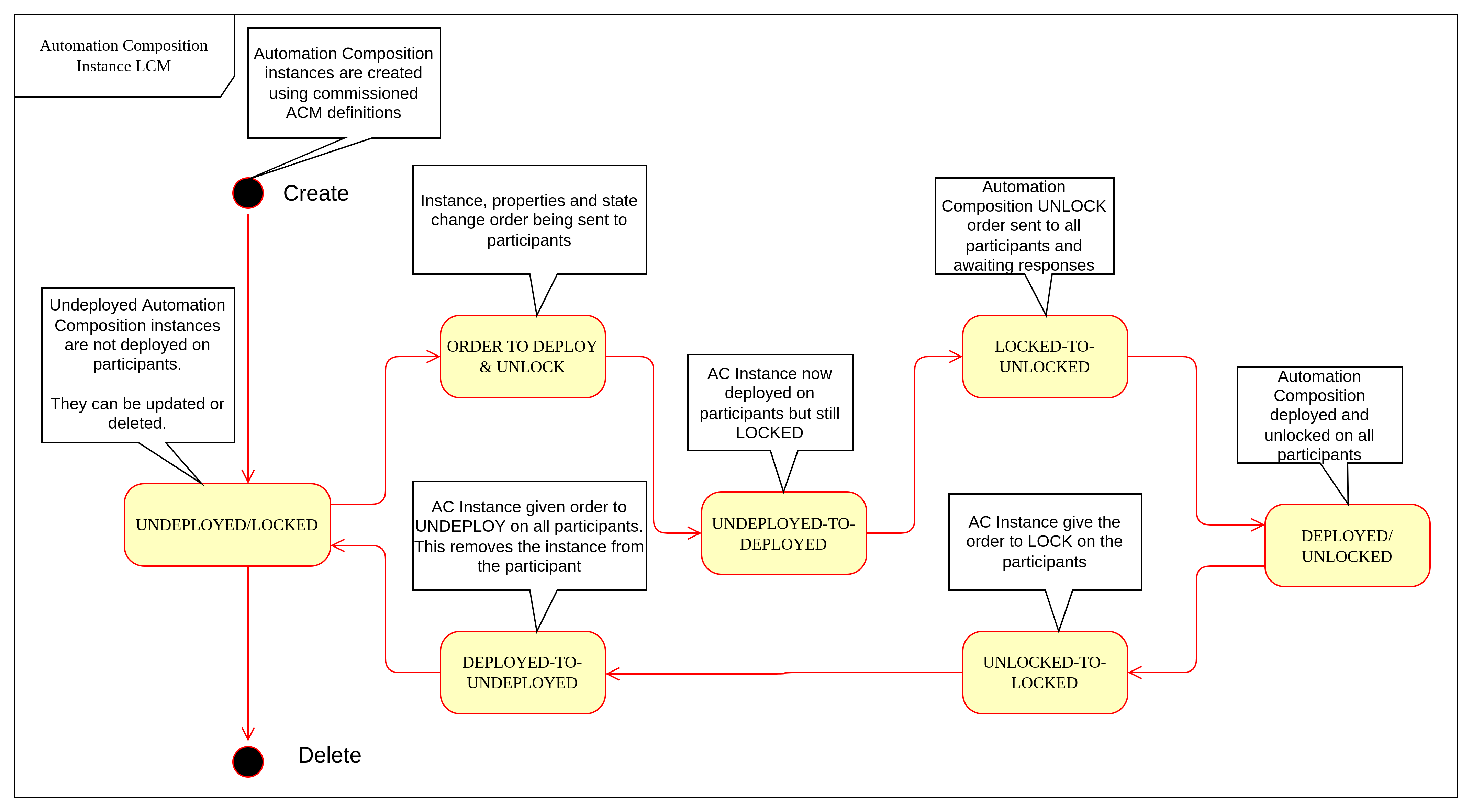
4 Overall Target Architecture
The diagram below shows an overview of the architecture of TOSCA based Automation Composition Management in ACM-R.
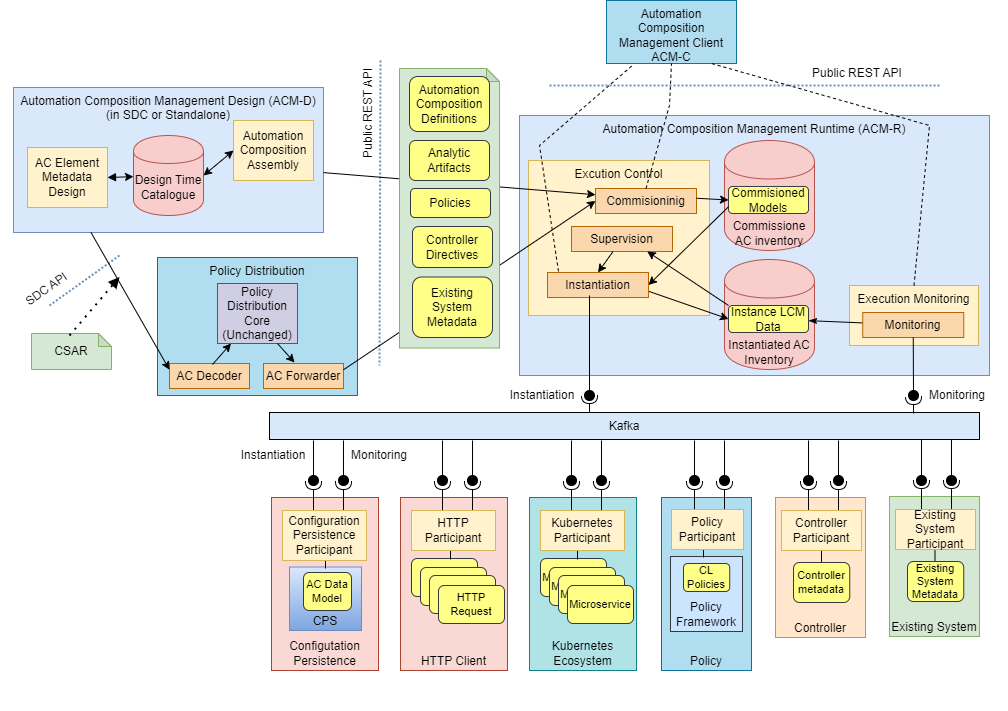
Following the ONAP Reference Architecture, the architecture has a Design Time part and a Runtime part.
The Design Time part of the architecture allows a user to specify metadata for participants. It also allows users to compose automation compositions. The Design Time Catalogue contains the metadata primitives and automation composition definition primitives for composition of automation compositions. As shown in the figure above, the Design Time component provides a system where Automation Compositions can be designed and defined in metadata. This means that a Automation Composition can have any arbitrary structure and the Automation Composition developers can use whatever analytic, policy, or control participants they like to implement their Automation Composition. At composition time, the user parameterizes the Automation Composition and stores it in the design time catalogue. This catalogue contains the primitive metadata for any participants that can be used to compose a Automation Composition. A Automation Composition SDK is used to compose a Automation Composition by aggregating the metadata for the participants chosen to be used in a Automation Composition and by constructing the references between the participants. The architecture of the Automation Composition Design Time part will be elaborated in future releases.
Composed Automation Compositions are commissioned on the run time part of the system, where they are stored in the Commissioned Automation Composition inventory and are available for instantiation. The Commissioning component provides a CRUD REST interface for Automation Composition Types, and implements CRUD of Automation Composition Types. Commissioning also implements validation and persistence of incoming Automation Composition Types. It also guarantees the integrity of updates and deletions of Automation Composition Types, such as performing updates in accordance with semantic versioning rules and ensuring that deletions are not allowed on Automation Composition Types that have instances defined.
The Instantiation component manages the Life Cycle Management of Automation Composition Instances and their Automation Composition Elements. It publishes a REST interface that is used to create Automation Composition Instances and set values for Common and Instance Specific properties. This REST interface is public and is used by the ACM GUI. It may also be used by any other client via the public REST interface. The REST interface also allows the state of Automation Composition Instances to be changed. A user can change the state of Automation Composition Instances as described in the state transition diagram shown in section 2 above. The Instantiation component issues update and state change messages via Kafka to participants so that they can update and manage the state of the Automation Composition Elements they are responsible for. The Instantiation component also implements persistence of Automation Composition Instances, automation composition elements, and their state changes.
The Monitoring component reads updates sent by participants. Participants report on the state of their Automation Composition Elements periodically and in response to a message they have received from the Instantiation component. The Monitoring component reads the contents of the participant messages and persists their state updates and statistics records. It also publishes a REST interface that publishes the current state of all Participants, Automation Composition Instances and their Automation Composition Elements, as well as publishing Participant and Automation Composition statistics.
The Supervision component is responsible for checking that Automation Composition Instances are correctly instantiated and are in the correct state (UNDEPLOYED/DEPLOYED/LOCKED/UNLOCKED). It also handles timeouts and on state changes to Automation Composition Instances, and retries and rolls back state changes where state changes failed.
A Participant is an executing component that partakes in automation compositions. More explicitly, a Participant is something that implements the Participant Instantiation and Participant Monitoring messaging protocol over Kafka for Life Cycle management of Automation Composition Elements. A Participant runs Automation Composition Elements and manages and reports on their life cycle following the instructions it gets from the ACM runtime in messages delivered over Kafka.
In the figure above, five participants are shown. A Configuration Persistence Participant manages Automation Composition Elements that interact with the ONAP Configuration Persistence Service to store common data. The DCAE Participant runs Automation Composition Elements that manage DCAE microservices. The Kubernetes Participant hosts the Automation Composition Elements that are managing the life cycle of microservices in automation compositions that are in a Kubernetes ecosystem. The Policy Participant handles the Automation Composition Elements that interact with the Policy Framework to manage policies for automation compositions. A Automation Participant such as the CDS Participant runs Automation Composition Elements that load metadata and configure controllers so that they can partake in automation compositions. Any third party Existing System Participant can be developed to run Automation Composition Elements that interact with any existing system (such as an operator’s analytic, machine learning, or artificial intelligence system) so that those systems can partake in automation compositions.
5. Other Considerations
5.1 Management of Automation Composition Instance Configurations
In order to keep management of versions of the configuration of automation composition instances straightforward and easy to implement, the following version management scheme using semantic versioning is implemented. Each configuration of a Automation Composition Instance and configuration of a Automation Composition Element has a semantic version with 3 digits indicating the major.minor.patch number of the version.
Note
A configuration means a full set of parameter values for a Automation Composition Instance.
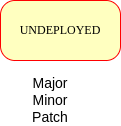
Change constraints:
An Automation Composition or Automation Composition Element in state UNDEPLOYED can be changed to a higher major/minor/patch level or rolled back to a lower major/minor/patch level. This means that where the structure of the entire automation composition is changed, the automation composition must be undeployed and redeployed.
If a Automation Composition Element has a minor version change, then its Automation Composition Instance must have at least a minor version change.
If a Automation Composition Element has a major version change, then its Automation Composition Instance must have a major version change.
5.2 Scalability
The system is designed to be inherently scalable. The ACM runtime is stateless, all state is preserved in the Instantiated Automation Composition inventory in the database. When the user requests an operation such as an undeploy, deploy, lock, or an unlock on a Automation Composition Instance, the ACM runtime broadcasts the request to participants over Kafka and saves details of the request to the database. The ACM runtime does not directly wait for responses to requests.
When a request is broadcast on Kafka, the request is asynchronously picked up by participants of the types required for the Automation Composition Instance and those participants manage the life cycle of its automation composition elements. Periodically, each participant reports back on the status of operations it has picked up for the Automation Composition Elements it controls, together with statistics on the Automation Composition Elements over Kafka. On reception of these participant messages, the ACM runtime stores this information to its database.
The participant to use on a automation composition can be selected from the registered participants in either of two ways:
Runtime-side Selection: The ACM runtime selects a suitable participant from the list of participants and sends the participant ID that should be used in the Participant Update message. In this case, the CLAMP runtime decides on which participant will run the Automation Composition Element based on a suitable algorithm. Algorithms could be round robin based or load based.
Participant-side Selection: The ACM runtime sends a list of Participant IDs that may be used in the Participant Update message. In this case, the candidate participants decide among themselves which participant should host the Automation Composition Element.
This approach makes it easy to scale Automation Composition life cycle management. As Automation Composition Instance counts increase, more than one ACM runtime can be deployed and REST/supervision operations on Automation Composition Instances can run in parallel. The number of participants can scale because an asynchronous broadcast mechanism is used for runtime-participant communication and there is no direct connection or communication channel between participants and ACM runtime servers. Participant state, Automation Composition Instance state, and Automation Composition Element state is held in the database, so any CLAMP runtime server can handle operations for any participant. Because many participants of a particular type can be deployed and participant instances can load balance automation composition element instances for different Automation Composition Instances of many types across themselves using a mechanism such as a Kubernetes cluster.
5.3 Sandboxing and API Gateway Support
At runtime, interaction between ONAP platform services and application microservices are relatively unconstrained, so interactions between Automation Composition Elements for a given Automation Composition Instance remain relatively unconstrained. A proposal to support access-controlled access to and between ONAP services will improve this. This can be complemented by intercepting and controlling services accesses between Automation Composition Elements for Automation Composition Instances for some/all Automation Composition types.
API gateways such as Kong have emerged as a useful technology for exposing and controlling service endpoint access for applications and services. When a Automation Composition Type is onboarded, or when Automation Composition Instances are created in the Participants, CLAMP can configure service endpoints between Automation Composition Elements to redirect through an API Gateway.
Authentication and access-control rules can then be dynamically configured at the API gateway to support constrained access between Automation Composition Elements and Automation Composition Instances.
The diagram below shows the approach for configuring API Gateway access at Automation Composition Instance and Automation Composition Element level.
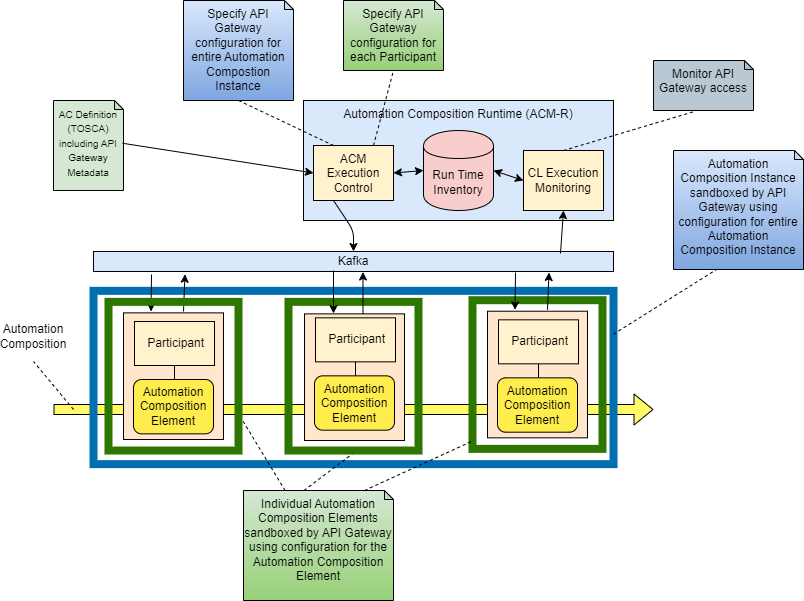
At design time, the Automation Composition type definition specifies the type of API gateway configuration that should be supported at Automation Composition and Automation Composition Element levels.
At runtime, the ACM-R can configure the API gateway to enable (or deny) interactions between Automation Composition Instances and individually for each Automation Composition Element. All service-level interactions in/out of a Automation Composition Element, except that to/from the API Gateway, can be blocked by networking policies, thus sandboxing a Automation Composition Element and an entire Automation Composition Instance if desired. Therefore, a Automation Composition Element will only have access to the APIs that are configured and enabled for the Automation Composition Element/Instance in the API gateway.
For some Automation Composition Element Types the Participant can assist with service endpoint reconfiguration, service request/response redirection to/from the API Gateway, or annotation of requests/responses.
Once the Automation Composition instance is instantiated on participants, the participants configure the API gateway with the Automation Composition Instance level configuration and with the specific configuration for their Automation Composition Element.
Monitoring and logging of the use of the API gateway may also be provided. Information and statistics on API gateway use can be read from the API gateway and passed back in monitoring messages to the ACM runtime.
Additional isolation and execution-environment sandboxing can be supported depending on the Automation Composition Element Type. For example: ONAP policies for given Automation Composition Instances/Types can be executed in a dedicated PDP engine instances; DCAE or K8S-hosted services can executed in isolated namespaces or in dedicated workers/clusters; etc..
6 APIs and Protocols
The APIs and Protocols used by CLAMP for Automation Compositions are described on the pages below:
7 Design and Implementation
The design and implementation of TOSCA Automation Compositions in CLAMP is described for each executable entity on the pages below:
End of Document